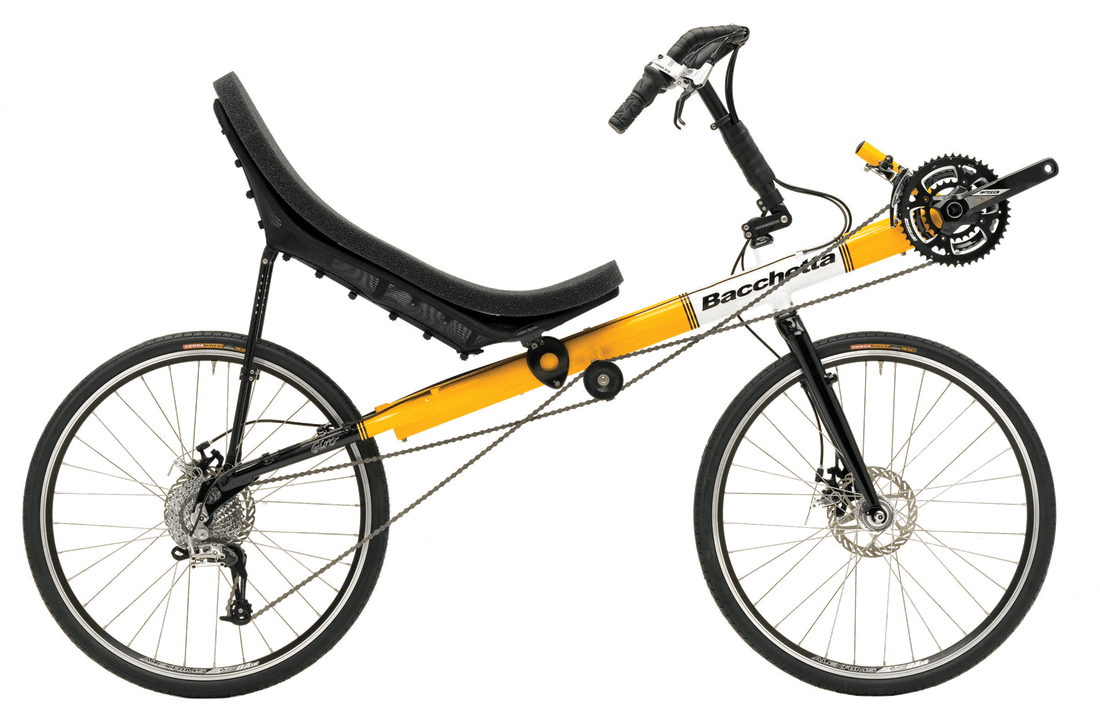Below is some general info regarding wheel sizes which will work on our Giro 26 bikes beyond the original stock wheels. If wheel sizes are a mystery to you, we highly recommend learning a little more about wheel sizes before reading the article. You can find general wheel and tire information, here: http://www.sheldonbrown.com/tire_sizing.html,
GIRO 26 AND 26 ATT FRAMES: THE BASICS
Both the Giro 26 (steel frame) and Giro 26 ATT (aluminum frame) come stock with 26” (ISO 559mm) wheels and 1.25” tires. Rear dropout spacing is standard MTB 135mm. Frames and forks come with disc brake tabs and canti posts for V-brakes positioned for 26” (559mm) wheels. Both Giro26 frames also have a rear brake boss for a traditional road brake caliper which will work with 700c wheels. Also, the steel and alloy forks available on these models have enough clearance for a 700 wheel with 23c+ tires. All of this makes both bikes extremely versatile as far as wheel sizes go, but there are a few things you’ll need to keep in mind before making any changes.
When buying wheels, you need to consider rear-end (dropout) spacing. All Giro frames use 135mm rear spacing, and almost all pre built 26” (559) rear wheels on the market have this hub spacing. You can use a rear wheel with 130mm spacing (the most common spacing for 700c wheels), but this requires squeezing the rear end of the frame with the QR to make it work. It’s only 2.5mm on either side; if you can live with that, you can save yourself some money and use those 700c wheels you have laying around. Also, since the MTB world has embraced the 29er size (700c rims + 2” tires = 29”), there are now plenty of off-the-shelf 700c wheel sets with 135mm rear hubs. But remember: most of these wheels are disc brake compatible only. Make sure and do your research before purchasing.
Strada and steel Corsa frames built in 2004 and earlier. These frames were pretty similar to the current Giro 26 and had enough room for a 700c rear wheel. These old Strada and Corsa’s, though, had no rear brake boss for a road caliber brake and no disc brake tab. For 700c wheels to work properly on these frames, the use of a Paul Components MOTO long reach V-brake is required. There may be other (cheaper) versions of this brake on the market, but I have not sourced them. If anyone knows of one please drop us a line.
GIRO-26 AND 26ATT FRAMES: WHEELS AND TIRE COMBOS THAT WORK
Dual 700c (622mm)*. This wheel size works on older models but only with 23c tires. Newer models (2011 and 2012) will take 25c tires without any issues. These wheels work with the stock frame and fork if you use disc brakes, Bacchetta or X-Eyed long reach road brakes, or the Paul MOTTO v-brake. If you already have a 700c rear wheel with standard 130mm road hub then, once again, you’ll have to squeeze the rear dropouts with the QR to make it work.
We have built up Giro-26’s using 700c wheels with 130mm rear hub spacing for testing and it works just fine. Both Bacchetta and X-Eyed road brake calipers work on the stock frame and aluminum fork. And while the steel fork does not allow the same brake/frame clearance as the aluminum fork, any 700c road fork with the correct size steer tube can replace the stock steel fork on the 2012 Giro 26. However, you’ll probably need to install a steer tube extender when running the Bacchetta front road brake (X-Eyed brakes clear the frame) so the brake caliper clears the frame.
* We now have Giro-26ATT’s in stock that can be ordered with our new 700c wheel set for an up charge of $100. These wheels have ALEX DA28 rims, a 24F/28R spoke count, sealed bearing Formula disc hubs with 135mm rear spacing and come with 25c Kenda Kriterium, 120psi tires. And the set weighs 19 oz. less than the stock wheels and tires. If you’re torn between getting a Giro-26ATT or a 700c Corsa… now you can have it all with a 700c Giro-26ATT.
Dual 26” (559mm) with tires up to 1.9”. Our stock tires are 1.25”. Please note that you can get a real speed boost on your stock wheels just by going to skinner high pressure 559mm tires. We really like the Schwalbe Ultremo-ZX (559×23) or the Schwalbe Durano (559×28) for that.
Dual 24” (507 or 520mm). These wheel sizes only work with disc brakes. 507mm wheels and tires are generally found on adult BMX bikes, and most of the rubber available comes in wider sizes. 520mm wheels and tires are generally found on kids’ road bikes, and the rubber for them is mostly the skinny roadie type.
I personally ride a Giro-26 set up with 24”, 507x38c, 100psi, micro knobby tires and it makes a great commuter. I’m six feet tall and can ride the stock wheels with no problems, but with fatter tires the bike gets a bit tall for my taste. With the smaller 507’s, I can get the cushier ride of the fatter tires and the seat actually gets a little closer to the ground which makes starting and stopping a no brainer (see more about this setup below).
Dual 20” (406 and 451mm). On the 26 frames these wheel sizes only work with disc brakes. And aesthetically speaking, this wheel size may look a bit odd in the 26 frame/fork. 406mm, 20” tires come in a wide variety of sizes, but 451mm, 20” tires are generally only available in skinny roadie sizes. The dual 20” combo in a Giro 26 frame is not a favorite of ours here at Bacchetta.
MORE RAMBLING ON THE SUBJECT OF WHEELS
As mentioned above, I have a Giro26 built up with 24” (507mm) wheels and 1.5” tires for commuting and touring. (These wheels were custom made at Power-On Cycling http://poweroncycling.com/). Since these wheels have disc hubs and the correct rear hub spacing of 135mm, there was no need to change anything else on the bike. I simply removed the stock wheels and replaced them with the 24’s. This set-up drops the seat height about one inch or so, and even thought it doesn’t seem like much, it makes getting a foot flat on the ground much easier and that’s something I really like, especially when loaded down for touring. The smaller rear wheel also gives me better gearing for hauling a load. And opposed to the dual 20” wheels, the 24’s look natural and work well with the stock gearing.
Yet another wheel combo that works well with the Giro 26: a 24” front and 26” rear. Please note that a 24” wheel requires using a disc brake. What I like about this wheel combo is that it gives you a bottom bracket (BB) height that’s midway between a Giro 20 and a Giro 26. This lower BB makes starts and stops about as easy as on a Giro 20, yet still rolls almost as fast as a dual 26. Something to keep in mind: the smaller front wheel does change the front end geometry but, IMHO, not in a bad way. The 507mm, 24” is a good choice if you’re looking for a touring set up. The 520mm, 24 is the way to go if you’re looking for a speed boost.
Hope that helps!
Mark
Originally posted on bacchettabikes.com on Oct. 29, 2012.



